Ijraset Journal For Research in Applied Science and Engineering Technology
- Home / Ijraset
- On This Page
- Abstract
- Introduction
- Conclusion
- References
- Copyright
Investigation of Air Quality for Malegaon Region
Authors: Chaitali S. Amrutkar, Shakshanki S. Jadhav, Ankita S. Pagar, Sakshi P. Kale, Ashwini R. Shardul, Sachin P. Harkal
DOI Link: https://doi.org/10.22214/ijraset.2024.61349
Certificate: View Certificate
Abstract
The purpose of this study is to examine the quality of the air in the Malegaon region by identifying, quantifying, and evaluating contaminants and their effects on the environment and public health. The Malegaon region\'s air quality has been a rising topic of concern because of industrial operations, vehicle emissions, and other human-caused factors. elevated concentrations of many pollutants, including Carbon Monoxide (CO), Nitrogen Dioxide (NO2), Sulphur Dioxide (SO2), Particulate matter (PM2.5, PM10), and Ozone (O3).It\'s an intriguing problem to comprehend the mechanics of air pollution in a semi-urban location like Malegaon. The dispersion and concentration patterns of pollutants are influenced by various factors, including terrain, meteorological circumstances, and industrial expansion. The challenge is further complicated by evaluating the combined effects of several pollution sources on air quality. In order to thoroughly evaluate the state of the air in the Malegaon region, this study uses a multidisciplinary method that combines statistical analysis, atmospheric modeling, and air quality monitoring.
Introduction
I. INTRODUCTION
In recent years, the Indian state of Maharashtra has seen a tremendous increase in both urbanization and industrialization in the city of Malegaon. Air quality issues have become a major environmental problem in the region due to growing industrial operations and population increase. Long-term environmental issues as well as urgent health dangers for locals are presented by the declining quality of the air.
The purpose of this study is to evaluate the degree of pollution levels across a range of parameters and explore the numerous factors influencing Malegaon's air quality. Understanding the sources, patterns, and implications of air pollution is vital for creating effective policies to alleviate its detrimental effects on public health and the environment. Identification of key sources of air pollution in Malegaon, including industrial emissions, automotive exhaust, construction activity, and biomass burning.
Measurement and assessment of major air pollutants, nitrogen dioxide (NO2), sulfur dioxide (SO2) and particulate matter (PM10). Examination of the negative effects of air pollution on Malegaon local health, focusing on respiratory conditions. Heart conditions and other associated hazards. Measuring the health cost of poor air quality emphasizes how urgent intervention.
II. LITERATURE REVIEW
Mohammad Asif, Pranav Mahajan, “Impact of COVID-19 lockdown and meteorology on the air quality of Srinagar city: A temperate climate region in Kashmir Himalayas” The report illustrates how the COVID-19 lockout measures affected six important air contaminants and meteorological indicators by highlighting their temporal variance. It is interesting to observe that during lockdown periods, some pollutants, like NH3 and NO2, witnessed significant declines, while other pollutants, like SO2 and O3, exhibited an increased tendency. This shows that human activity, climatic factors, and lockdown procedures interact intricately to affect air quality. The results highlight the possible advantages of enforcing strict lockdown protocols during periods of severe air pollution in order to lessen the detrimental effects of pollutants from a variety of sources, such as industrial and vehicle sources.
Aditya Dubey, Akhtar Rasool, “Impact on Air Quality Index of India Due to Lockdown”, Particulate matter (PM)2.5, PM10, nitrogen dioxide (NO2), and the Air Quality Index (AQI) all significantly decreased during the lockdown, according to the study in the report, indicating improved air quality standards and cleaner air. This shows that, despite possible negative effects on economic growth, even brief lockdowns can be beneficial in reducing air pollution.
C.M.Payus, M.S. Nur Syazin, “Extended air pollution index (API) as tool of sustainable indicator in the air quality assessment: EI-Nino events with climate change driven”, This main purpose of this research is to detect the air quality The major goal of this research is to identify changes in air quality over a shorter timeline in space, which will help to enhance and optimize risk characterization and concurrent air quality evaluation.
Many different physical, chemical, and biological parameters, such as temperature, humidity, air pressure, particle matter (PM), carbon monoxide (CO), and sulphur dioxide (SO2), can be used to determine the quality of the air. However, since each measure signals a distinct sort of quality class, it is frequently difficult to comprehend the results of the air quality status when many quality elements are studied.
Yiyi Wang, Lei Huang, et al, “High-resolution modelling for criteria air pollutants and the associated air quality index in a metropolitan city”, the discovery that high ground-level ozone exposure over a wide area dominates the spatial pattern of bad air quality, which is defined as an AQI greater than 100. This emphasizes how important ground-level ozone is as a primary cause of the analysed metropolitan city's poor air quality. To improve air quality and public health in metropolitan areas, tailored interventions and regulations that take into account the main pollutants causing poor patterns of air quality are essential.
III. METHODOLOGY
To check sound quality, systematic data collection methods are applied. A To check sound quality, systematic data collection methods are applied.
A general strategy for sound quality monitoring is as follows:
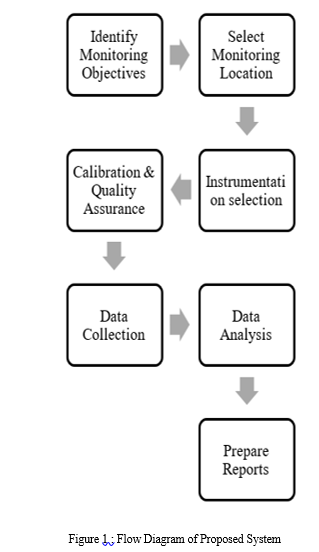
IV. STUDY AREA
In the Indian state of Maharashtra, in the Nashik District, is the city and Municipal Corporation of Malegaon. Situated along the Girna River, the city is divided into two pieces by the Mosam River, which flows through its center. Malegaon's loom industries are well-known. Malegaon is located at 18.42°N 77.53°E, at the junction of the Girna and Mosam rivers, at an elevation of 438 meters (1437 feet). Mumbai, the state capital, is located 280 miles to the northeast. It is well connected to neighboring cities like Nashik, Pune,Mumbai, Indore, Surat, and Dhule due to its central location. Malegaon's total area is 33.56 km² (1296 sq. m), with an elevation of 438 m (1437 ft.). Malegaon's total population is 481228.
Measurement of Samples
Seven randomly selected sampling locations were used to cover the Industrial and Residential study region, as depicted in Figure 2. In the sampling design for the study area, the residential area received one point, the industrial area received three points, the educational area received one point, and the bus stand area received two points.
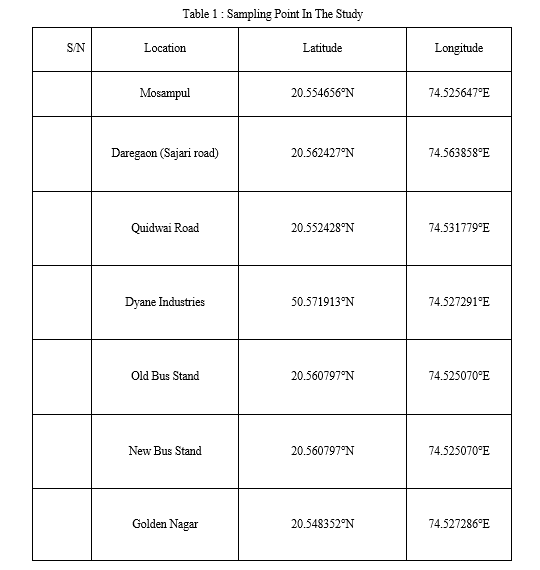
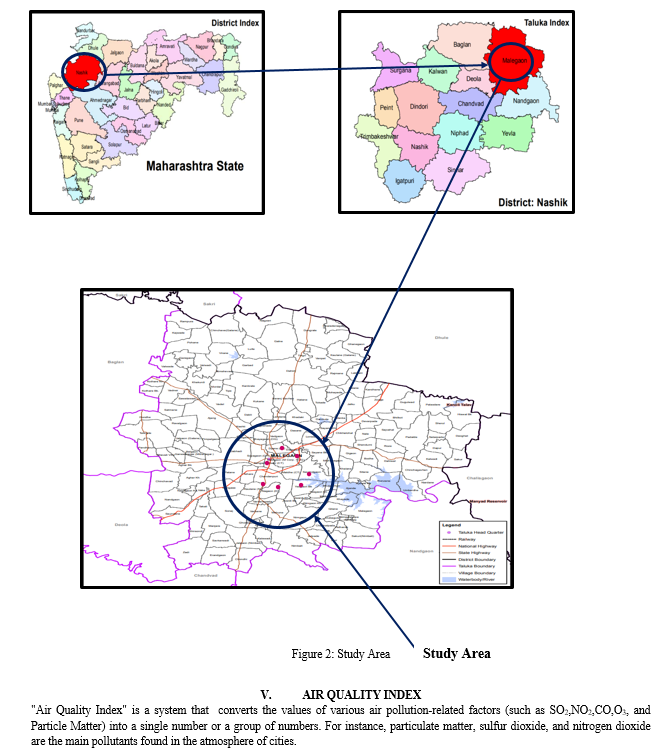
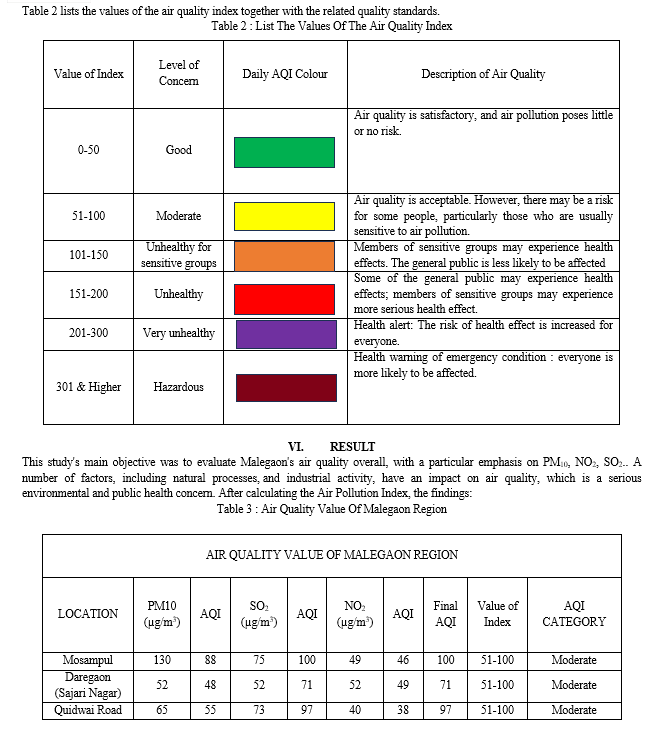
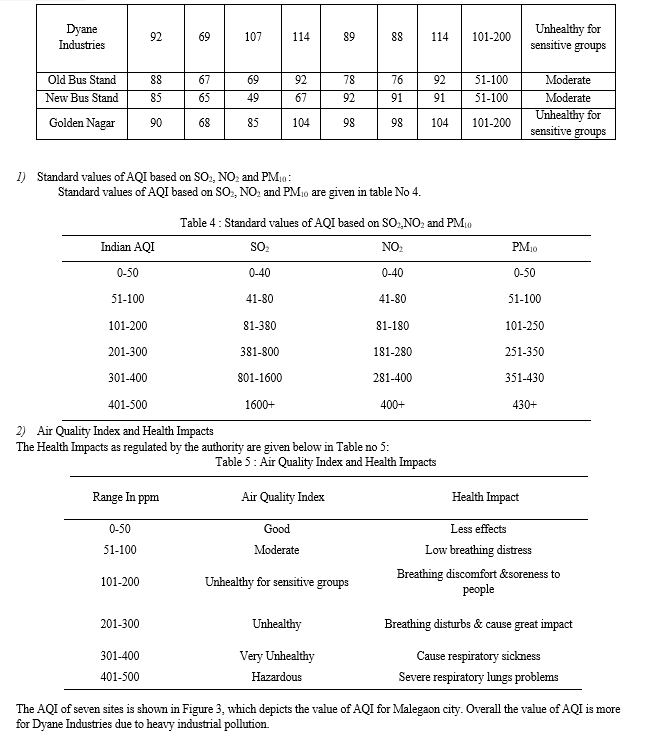
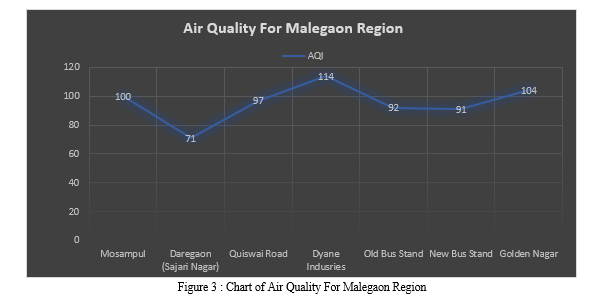
VII. DISCUSSION
- The sources of air pollution in our study are industrial source.
- The air quality of Malegaon city is from AQI 71 to 114 which is unhealthy to breathe for humans.
- Since AQI has an adverse effect on human health, revising Air quality is evident.
- The data collected from air quality parameters are like, PM10, NO2, of each site is discussed in result.
- Since AQI needs data regarding CO2, CO, O3 also, but High Volume Sampler was unable to detect these gases. This is the limitations of our instrument.
- Mitigation strategies like afforestation, use of filter in chimneys, should be implemented to reverse the effect of air pollution.
VIII. MITIGATION METHODS
To enhance overall quality of site in Malegaon regarding Air quality some mitigations should be implemented like,
- Afforestation
- Air stripers
Conclusion
1) Air quality of Malegaon is unhealthy and need to be revised. 2) Air quality of Malegaon is affected due to industrial sources. 3) AQI primarily depends upon various factors like, temperature, seasonal variation, altitude, location etc. 4) AQI also depends upon PM10 values; the range of AQI varies with value of PM10. 5) AQI need major issues to be addressed, but pollutants like CO, CO2, and O3 are not addressed due to limitation of instrument. In future these parameters can be thoroughly monitored. 6) Last but not the least, human intervention in Environment has led to adverse effect of air quality and ultimately resulted in damaged to air quality.
References
[1] P.?Aruna Rani, Dr.?V. Sampathkumar, “A novel artificial intelligence algorithm for predicting air quality by analysing the pollutant levels in air quality data in tamilnadu,” e-Prime - Advances in Electrical Engineering, Electronics and Energy, Volume 5, 2023, 100234, ISSN 2772-6711. [2] Yiyi Wang, Lei Huang, Conghong Huang, Jianlin Hu, Meng Wang, \"High-resolution modeling for criteria air pollutants and the associated air quality index in a metropolitan city, Environment International,\" Volume 172, 2023, 107752, ISSN 0160-4120. [3] Waheb A. Jabbar, Thanasrii Subramaniam, Andre Emelio Ong, Mohd Iqmal Shu\'Ib, Wenyan Wu, Mario A. de Oliveira, \"LoRaWAN-Based IoT System Implementation for Long-Range Outdoor Air Quality Monitoring,\" Internet of Things, Volume 19, 2022, 100540,ISSN 2542-6605. [4] Mohammad Asif, Pranav Mahajan, “Impact of COVID-19 lockdown and meteorology on the air quality of Srinagar city: A temperate climatic region in Kashmir Himalayas,” Hygiene and Environmental Health Advances, Volume 4, 2022, 100025, ISSN 2773-0492. [5] C.M. Payus, M.S. Nur Syazni, J. Sentian, \"Extended air pollution index (API) as tool of sustainable indicator in the air quality assessment: El-Nino events with climate change driven,\" Heliyon, Volume 8, Issue 3, 2022, e09157, ISSN 2405-8440, [6] Xihao Du, Renjie Chen, Xia Meng, Cong Liu, Yue Niu, Weidong Wang, Shanqun Li, Haidong Kan, Maigeng Zhou, \"The establishment of National Air Quality Health Index in China,\" Environment International, Volume 138, 2020, 105594, ISSN 0160-4120, [7] Kianisadr M, Ghaderpoori M, Jafari A, Kamarehie B, Karami M. “Zoning of air quality index (PM10 and PM2.5) by Arc-GIS for Khorramabad city, Iran” ,Pubmed,2018,1131-1141. [8] Monteiro, A., Vieira, M., Gama, C. et al. “Towards an improved air quality index”, Air Quality Atmosphere and Health 10, 447–455 (2017). [9] Kanchan, Amit Kumar Gorai, and Pramila Goyal, “A Review on Air Quality Indexing System.” Asian Journal of Atmospheric Environment, Vol. 9-2, pp. 101-113, June 2015. [10] Pak Lun Fung, Salla Sillanpää, Jarkko V. Niemi c, Anu Kousac, Hilkka Timonen d. “Improving the current air quality index with new particulate indicators using a robust statistical approach”, Science of The Total Environment, Volume 844, 20 October 2022, 157099. [11] Singh A, Spak SN, Stone EA, Downard J, Bullard R, Pooley M, Kostle PA, Mainprize MW, Wichman MD, Peters T, Beardsley D, Stanier CO. “Uncontrolled combustion of shredded tires in a landfill -Part 2: Population exposure, public health response, and an air quality index for urban fires.” Atmos Environ (1994). 2015 Mar; 104,273-283. [12] Dr. Nilesh Maltare, Dr. Safvan “Vahora Air Quality Index prediction using machine learning for Ahmedabad city” Digital Chemical Engineering Volume 7, June 2023, 100093. [13] Amir Hossein Khoshakhlagh a,Mahdiyeh Mohammadzadeh ,Simone Morais c. “Air quality in Tehran, Iran”: Spatio-temporal characteristics, human health effects, economic costs and recommendations for good practice Atmospheric Environment: X, Volume 19, August 2023, 100222 [14] D. Ganeshkumar, V. Parimala, S. Santhoshkumar, “Air and Sound Pollution Monitoring System Using Cloud Computing”, International Journal of Engineering Research & Technology (IJERT) Vol.9 Issue 06, June-2020 [15] Ogunyemi Akinsanmi* , Oguntoke Olusegun and Adeofun Clement, “Assessment of Air and Noise Pollution from Industrial Sources in Ibadan, Southwest, Nigeria” Environment and Natural Resources Journal, 2019; 17(X): XX-XX [16] David Montes González, Juan Miguel Barrigón Morillas, Guillermo Rey-Gozalo, \"Different types of criteria for dealing with anomalous noise events in urban environments under stable road traffic flow conditions,\" Applied Acoustics, Volume 204, 2023, 109241, ISSN 0003-682X, [17] Heather O\'Leary, Scott Parr, Marwa M.H. El-Sayed, \"The breathing human infrastructure: Integrating air quality, traffic, and social media indicators,\" Science of The Total Environment, Volume 827, 2022, 154209, ISSN 0048-9697. [18] Zander S. Venter, Helene Figari, Olve Krange, Vegard Gundersen, \"Environmental justice in a very green city: Spatial inequality in exposure to urban nature, air pollution and heat in Oslo, Norway,\" Science of The Total Environment, Volume 858, Part 3, 2023, 160193, ISSN 0048-9697. [19] Brendan O\'Leary, John J. Reiners Jr, “Identification and influence of spatio-temporal outliers in urban air quality measurements”, Science of the Total Environment, 573 (2016) 55–65. [20] Samantha Di Loreto, Fabio Serpilli, Valter Lori, Stefano Squartini, \"Sound quality evaluation of kitchen hoods,\" Applied Acoustics, Volume 168, 2020, 107415, ISSN 0003-682X. [21] Xiaochuan Li, Yefeng Jiang, Jianxin Zhu, Li Wang, Mingrui Zhang, Xinhao Xu, Zhenchang Fang, Yuxuan Zhuo, Xinli Zhao, Zhihao Li, Yi Cao, \"Air curtain dust-collecting technology: Investigation of industrial application in tobacco factory of the air curtain dust-collecting system,\" Process Safety and Environmental Protection, Volume 149, 2021, Pages 676-683, ISSN 0957-5820, [22] Sami D. Harni, Sanna Saarikoski, Joel Kuula, Aku Helin, Minna Aurela, Jarkko V. Niemi, Anu Kousa, Topi Rönkkö, Hilkka Timonen, \"Effects of emission sources on the particle number size distribution of ambient air in the residential area,\" Atmospheric Environment, Volume 293, 2023, 119419, ISSN 1352-2310. [23] Prashant Kumar, Hamid Omidvarborna, Runming Yao, \"A parent-school initiative to assess and predict air quality around a heavily trafficked school,\" Science of The Total Environment, Volume 861, 2023, 160587, ISSN 0048-9697, [24] Pak Lun Fung, Salla Sillanpää, Jarkko V. Niemi, Anu Kousa, Hilkka Timonen, Martha Arbayani Zaidan, Erkka Saukko, Markku Kulmala, Tuukka Petäjä, Tareq Hussein, \"Improving the current air quality index with new particulate indicators using a robust statistical approach,\" Science of The Total Environment, Volume 844, 2022, 157099, ISSN 0048-9697, [25] Jielan Xie, Tianle Sun, “Quantitative evaluation of impacts of the steadiness and duration of urban surface wind patterns on air quality”, Science of the Total Environment, 850 (2022), 157957. [26] Simone Torresin, Rossano Albatici, Francesco Aletta, Francesco Babich, Tin Oberman, Stefano Siboni, Jian Kang, \"Indoor soundscape assessment: A principal components model of acoustic perception in residential buildings,\" Building and Environment, Volume 182, 2020, 107152, ISSN 0360-1323.
Copyright
Copyright © 2024 Chaitali S. Amrutkar, Shakshanki S. Jadhav, Ankita S. Pagar, Sakshi P. Kale, Ashwini R. Shardul, Sachin P. Harkal. This is an open access article distributed under the Creative Commons Attribution License, which permits unrestricted use, distribution, and reproduction in any medium, provided the original work is properly cited.

Download Paper
Paper Id : IJRASET61349
Publish Date : 2024-04-30
ISSN : 2321-9653
Publisher Name : IJRASET
DOI Link : Click Here
 Submit Paper Online
Submit Paper Online

